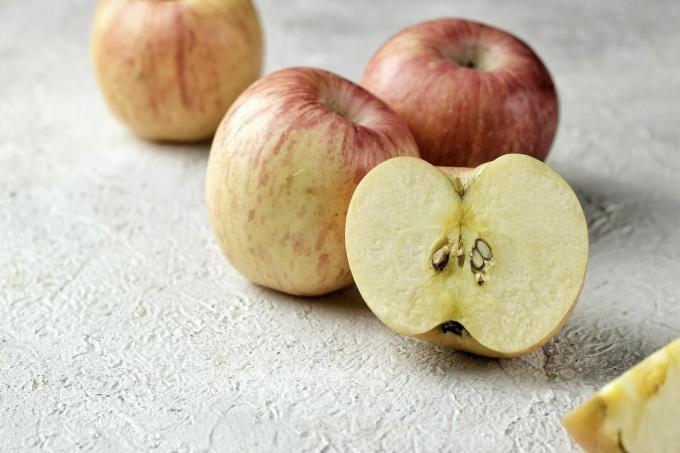Resilient and early carrying - these are the characteristics of the ‘Fießers Erstling’. In our article we will tell you which garden and which use the apple variety is suitable for.

Strong growth, high vitality and secure yields are the hallmarks of ‘Fießer's debut’. The old apple variety is known as an excellent commercial and cider apple and has also found some enthusiasts among hobby gardeners. The ‘Fießers Erstling’ is particularly suitable because of its extraordinary health, but also because of its undemanding nature, which also allows it to be grown in rougher areas. The apple is therefore extremely well suited for private cultivation.
"Contents"
- Fießer's first product: profile
- Origin and history of the apple
- Fießers first apple: appearance and taste
- Cultivation and care of the apple variety ‘Fießer's first fruit‘
- Harvest and use Fießer's first fruit
Fießer's first product: profile
| fruit | medium to large in size; light green base color with yellow body color and carmine-red stripes on the sunny side |
| taste | strongly sour, not very sweet, milder taste after storage |
| Yield | high and regular |
| Harvest time | September to October |
| Shelf life | very good; storable until March |
| growth | strong |
| climate | suitable for harsher climates and altitudes |
| Diseases and pests | very low susceptibility to powdery mildew and scab |
Origin and history of the apple
The ‘Fießers Erstling’ was created around 1980 by the breeder G. H. Fießer in Baden-Baden as a seedling of a ‘Bismarck apple’. The variety owes its unusual name to a special property: its breeder noticed that the tree already begins to bloom as a seedling at the age of four - this makes ‘Fießer's debut’ one of the earliest to bloom Apple trees. The variety has been officially available in stores since 1898 and quickly secured its reputation as a robust and high-yielding apple. Unfortunately, the ‘Fießer's first ’has lost its popularity over time, so that it is now on the red list of endangered domestic crops in Germany.
Fießers first apple: appearance and taste
With a weight of around 140 grams, the ‘Fießers Erstling’ can present medium-sized to large fruits. The somewhat irregularly shaped, spherically flattened or conical apples have a light green base color that later turns into a rich yellow. On the sunny side, the ‘Fießers Erstling’ often even has attractive, carmine-red stripes. The smooth, shiny and supple skin makes the apple an attractive eye-catcher. Also noticeable is the shallow steep pit, which, thanks to three broad edges, often appears weakly triangular. But the ‘Fießers Erstling’ is not only convincing with its appearance - the old apple variety can also score with inner values. The pulp of the ‘Fießers Erstling’ is brilliant white and has a juicy, loose texture. The high acid value (10.5 grams per liter) gives the apple a strongly sour taste, which is why it is usually not suitable as a table apple fresh. However, the acidity drops during storage, so that the ‘Fießers Erstling’ has a significantly milder taste after storage. The sugar value of the ‘Fießers Erstling’ is also in the relatively low range at around 13%.

Cultivation and care of the apple variety ‘Fießer's first fruit‘
Especially because of its high robustness, the ‘Fießers Erstling’ is a well-suited variety for cultivation in the hobby garden, provided there is enough space to offer the strongly growing tree. Depending on the substrate, its demands on the soil are low, only very dry and very nutrient-poor soils are not ideal for cultivation. At the same time, the ‘Fießers Erstling’ is considered to be particularly frost-hardy and is therefore also suitable for harsher climates and high altitudes. In its youth, the ‘Fießers Erstling’ proves to be vigorous and grows into an upright tree with a highly spherical crown without pruning. Typically, the ‘Fießers Erstling’ is cultivated as a high or half trunk or as a bush tree. Upbringing to small forms such as potted fruit is possible, but is rarely carried out. In the case of tall and half-trunks on strong-growing roots, it is advisable to choose an extensive cultivation method, especially at a young age, because of the strong growth. In addition, the apple tree should only be thinned every few years if necessary. Lower trunks and bush trees, on the other hand, should be slightly pruned every year - this way, vegetative growth is only minimally stimulated and no alternation is provoked. The mid-late flowering of ‘Fießer's debut’ is considered to be particularly insensitive. The varieties ‘have proven to be good pollinators for the‘ Fießers Erstling ’Oldenburg' and 'James Grieve‘Proven. The very good health of the old apple variety is also convincing - there is only a very low susceptibility to powdery mildew and scab. As a rule, you can only see healthy apple trees of the ‘Fießers Erstling’ variety, even in the most unfavorable locations.
Harvest and use Fießer's first fruit
Even at a young age, the ‘Fießers Erstling’ bears fruit regularly and in abundance. Alternating, i.e. fluctuating, yields are seldom found with this variety. The apples are ready to be picked between September and October and can be stored. Because of its fresh acidity and its high juice content, the ‘Fießers Erstling’ is particularly suitable as a cider apple. But it is also used as a table apple. However, the strong acidity makes the young apple inedible for most people. Only after longer storage, at the beginning of the following year, is the acid sufficiently broken down and the apple's taste becomes more pleasant. Fortunately, the ‘Fießers Erstling’ impresses with its particularly good storage properties. If you store the apple correctly, it can be kept until March without any problems.

The ‘Fießer's first fruit’ is not the right apple for you yet? You might find the right apple tree in our article about old and well-tried apple varieties.
